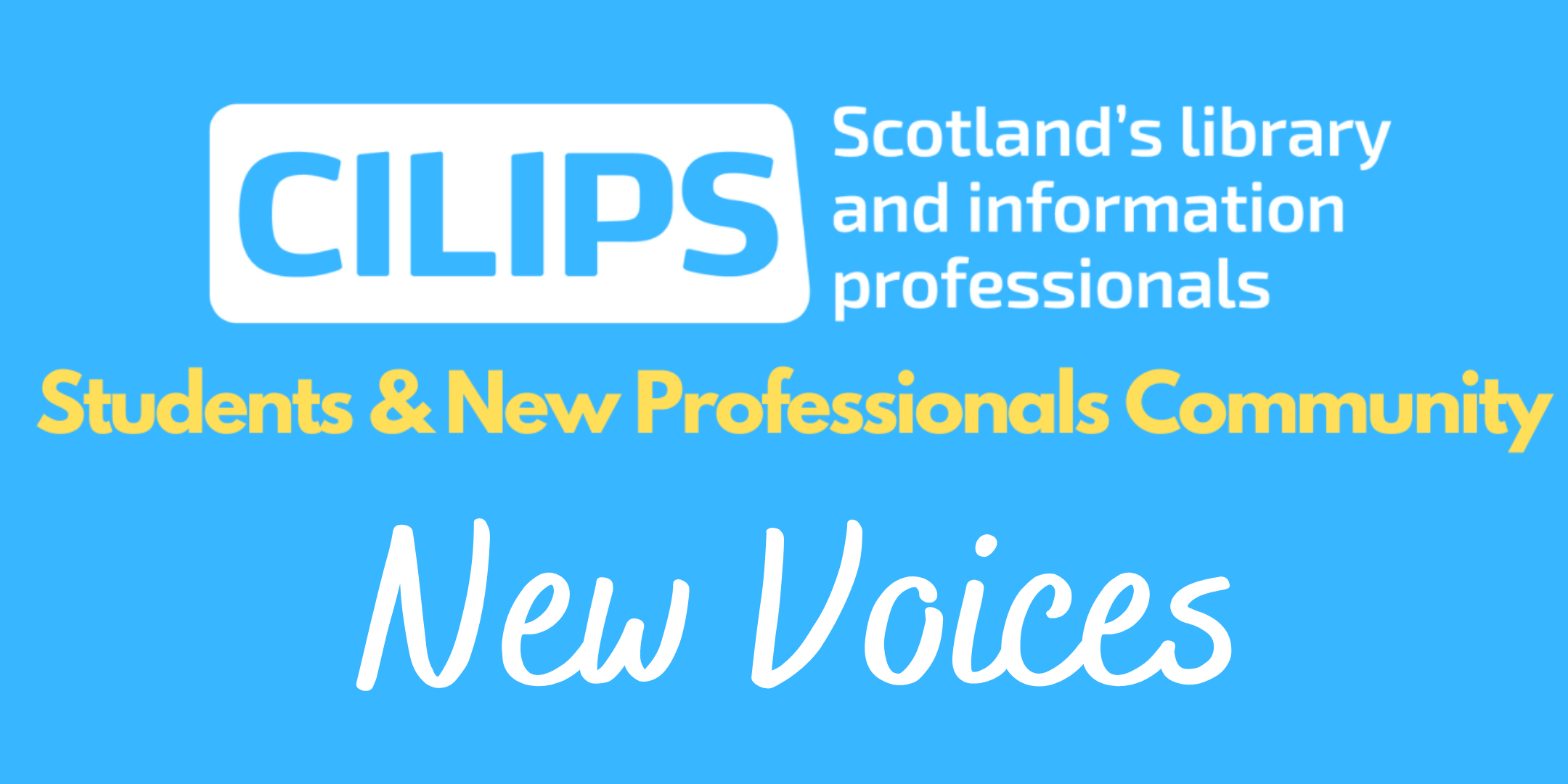New Voices RGU Student Series 2023 – Isabel Virgo
Category: Blog, New Voices, New Voices, RGU Student Series

In this 2023 Student Series for the New Voices blog, the CILIPS Students & New Professionals Community will be sharing the views of Robert Gordon University students from the MSc in Information and Library Studies. With special thanks to Dr Konstantina Martzoukou, Teaching Excellence Fellow and Associate Professor, for organising these fantastic contributions. This series will be shared by CILIPS Graduate Trainee Leah Higgins.
Thank you to RGU student Isabel Virgo for her valuable contribution to the blog. Isabel is an Academic Liaison Librarian at Oxford Brookes University (Business School). She currently in the second year of part-time study for a Doctorate in Information Science with Robert Gordon University, and her thesis will focus on the information behaviour of higher education students in prison.
An “irreversible digital divide”? Information and digital literacies in a prison education context
Imagine a place in a modern developed nation where the majority of tasks are still completed on paper, residents have no means to access the internet at a time of their choosing, and all the information they consume is subject to strict censorship. These places exist, and they are home to more than 80,000 people in the UK alone. The places I am referring to are prisons, and these issues are significant challenges for information professionals working within them, presenting unique obstacles to prisoners’ development of information and digital literacy skills that will be crucial when they are released into the community.
What are information and digital literacies?
The Association of College and Research Libraries (ACRL) neatly defines information literacy in their glossary (no date) as “The set of skills needed to find, retrieve, analyze, and use information” or more specifically in an education context as “the set of integrated abilities encompassing the reflective discovery of information, the understanding of how information is produced and valued, and the use of information in creating new knowledge and participating ethically in communities of learning.” (ACRL, 2015). CILIP’s (2018) definition focusses on criticality, stating that: “Information literacy is the ability to think critically and make balanced judgements about any information we find and use. It empowers us as citizens to develop informed views and to engage fully with society.” This is particularly crucial in a prison context, since most prisoners will eventually be released and the capacity to engage with society is a key factor in avoiding recall to prison (UNODC, 2018).
Definitions and frameworks for information literacy have proliferated in recent years, in part to encompass new (predominantly digital) sources and channels of information. A review conducted by a partnership of Irish Higher Education institutions (All Aboard, 2015, cited in Brown, 2017) found over 100 frameworks depicting digital literacies. One of the most frequently cited in education settings is JISC’s (2015) ‘Digital capability framework’, which cites a broad range of skills for information creation and use, with ICT proficiency at the centre and digital wellbeing as an overarching theme.
Sharpe and Beetham’s (2010) pyramid model, reminiscent of Maslow’s hierarchy of needs, depicts the development of digital literacy as layers of competence, building from Access and awareness (‘I have…’), through Skills (‘I can…’), Practices (‘I do…’) to Identity (‘I am…’). This model is useful, particularly in this context, as it shows that without reliable access to digital tools, it is difficult to develop relevant skills. Many disadvantaged groups still lack this access (Good Things Foundation, 2022).
Why are these literacies important in prisons?
In prison, it is difficult to get beyond the first level of Sharpe and Beetham’s pyramid. For security reasons, prisoners are not permitted unsupervised access to the internet. Illicit possession of smartphones is common but risky (Homer, 2018). A review of prison education by the Education Committee (2022) found that the majority of prisons in England and Wales do not currently have broadband infrastructure. As Sharpe and Beetham (2010, p. 90) argued, “Without reliable, convenient and cost-effective access, none of the other attributes of effective e-learners can be brought into play”.
Education in prisons is key to the rehabilitation of offenders, with a Ministry of Justice (2018) review finding that participation in prison education significantly increased post-release employment and reduced re-offending. The Education Committee review (2022) recommended that all prisoners engaging in education should have access to ‘locked down’ laptops in their cells, allowing access to specific content and communication channels for educational purposes. Although this may go some way towards supporting that group, a prisoner interviewed by Pike and Adams (2012, p.372) reflected on a similar arrangement: “It [Virtual Campus] doesn’t really help me as a person… it’s limited, at the end of the day the internet really means unlimited.” The issue is not only one of information access, but opportunities to learn to find and evaluate this information. The acquisition of modern information and digital literacies is particularly crucial for those who have been incarcerated for long periods, since their lack of exposure to our digital society can be a significant hindrance and constitute an “irreversible digital divide” (Novo-Corti and Barreiro-Gen, 2017, p. 391).
Information professionals in prisons
IFLA’s Guidelines for library services to prisoners (2005, p.4) state that “Prison libraries should emulate the public library model, while at the same time providing resources for prison education and rehabilitation programs”. Prison librarians have a wide range of responsibilities, similar to public librarians (e.g. cataloguing stock, reference enquiries and ICT support) and face additional challenges such as security and censorship, as well as frequent under-resourcing. Finlay and Bates (2018) note that there is scant research on user experience in prison libraries and argue that this area should be expanded, while also recognising that the complex needs and backgrounds of users make evaluation of services more challenging. In common with authors like Castro and Gould (2018) and Evans (2018), they argue that the narrative in prison education literature is too strongly focused on ‘correction’ but there is “a window of opportunity for the fuller realisation of the possibilities of the prison library” (Finlay and Bates, 2018, p.120).
Examples of best practice
Burnett and Maruna (2006) argue for a “strengths-based” approach which recognises individuals’ capacity for positive change, which suggests that prison libraries should focus on developing these strengths. Both librarians and teachers in prisons have a responsibility to contribute to the rehabilitative mission of prisons and, as noted above, information and digital literacies are essential skills. Prison libraries should explore and build on prisoners’ existing skills, reinforcing and updating these where necessary to give individuals confidence that they can cope in society post-release.
While formal learning leading to qualifications is helpful for post-release employment, Finlay and Bates (2018) also point to the importance of ‘informal learning opportunities’ such as book clubs, creative writing classes and opportunities to read with their children. Since these are not enforced and are driven by the prisoners’ own interests, they are likely to get a more enthusiastic response from people who lack autonomy in many areas of their lives. They cite and example from Canada in which these opportunities are created and shaped by prisoners themselves (Lang and Sacuta, 2014, cited in Finlay and Bates, 2018).
Is there a role for using formal IL frameworks in prison? Kuntz Balcher (2020) attempted to use ACRL’s (2015) Framework for Information Literacy for Higher Education in a prison setting and found it to be a rewarding but challenging experience, complicated by a lack of sustained access to the group – “How was I to teach them about “Scholarship as Conversation,” when we could not even have a sustained conversation?” (p.179). She concluded that teachers must “radically redesign their courses to fit within the regulations of the correctional facility” (p.180). Deeper collaborations between colleges and universities and prisons may provide a solution; in Italy, for example, universities are embedded in prisons through Prison University Campuses (Pastore, 2018).
Conclusion
Prisoners lack basic autonomy over their lives, and this is a significant challenge for the development of information and digital literacies. Policy-makers must recognise that the rehabilitative mission of prisons is severely restricted by outdated infrastructure and lack of opportunity for prisoners to access digital information sources and move forward with the Education Committee’s recommendations that secure access to technology is made available, particularly to those pursuing educational opportunities. Information professionals have the skills to support this change by offering informal learning opportunities, pursuing partnerships with educational institutions and, crucially, building on prisoners’ pre-existing strengths and knowledge.
Thank you to Isabel for such a valuable contribution to the blog, looking at Information and Digital literacies in a prison education context.
Stay tuned for more in the 2023 New Voices RGU Student Series coming soon and be sure to check out the rest of CILIPS SNPC’s New Voices blog.
Bibliography
ACRL, no date. Information literacy glossary. [online]. Available from: https://www.ala.org/acrl/issues/infolit/overview/glossary [Accessed 5 December 2022].
ACRL, 2015. Framework for Information Literacy for Higher Education. [online]. Available from: https://www.ala.org/acrl/standards/ilframework [Accessed 5 December 2022].
BROWN, M., 2017. A critical review of frameworks for digital literacy: beyond the flashy, flimsy and faddish. [online]. Available from: https://blog.ascilite.org/a-critical-review-of-frameworks-for-digital-literacy-beyond-the-flashy-flimsy-and-faddish-part-1/ [Accessed 30 November 2022].
BURNETT, R. and MARUNA, S., 2006. The kindness of prisoners: Strengths-based resettlement in theory and in action. Criminology & Criminal Justice, 6(1), pp. 83–106.
CILIP, 2018. What is information literacy? [online]. Available from: https://www.cilip.org.uk/news/421972/What-is-information-literacy.htm [Accessed 29 November 2022].
EDUCATION COMMITTEE, 2022. Not just another brick in the wall: why prisoners need an education to climb the ladder of opportunity. [online]. Available from: https://publications.parliament.uk/pa/cm5803/cmselect/cmeduc/56/report.html [Accessed: 29 November 2022].
FINLAY, J. and BATES, J., 2018. What is the role of the prison library? The development of a theoretical foundation. Journal of Prison Education and Reentry, 5(2), pp. 120-139.
GOOD THINGS FOUNDATION, 2022. The digital divide. [online]. Available from: https://www.goodthingsfoundation.org/the-digital-divide/ [Accessed: 5 December 2022].
HOMER, A., 2018. UK prisons ‘awash’ with smuggled phones and SIM cards. 18 May. [online]. Available from: https://www.bbc.co.uk/news/uk-england-43869560 [Accessed 2 December 2022].
JISC, 2015. Building digital capability. [online]. Available from: https://www.jisc.ac.uk/rd/projects/building-digital-capability [Accessed 5 December 2022].
KUNTZ BALCER, C., 2020. The Framework for Information Literacy for Higher Education (in prison): Using the frames to teach incarcerated students. College & Research Libraries News, 81(4), pp.178-181.
MINISTRY OF JUSTICE, 2018. Evaluation of prisoner learning: Initial impacts and delivery. [online]. Available from: https://assets.publishing.service.gov.uk/government/uploads/system/uploads/attachment_data/file/708156/evaluation-of-prisoner-learning-initial-impacts-report.pdf [Accessed 5 December 2022.
NOVO-CORTI, I. and BARREIRO-GEN, M., 2017. Additional barriers to access to labour market for prisoners due to digital isolation. In: CAMPOS-FREIRE, F. (Ed.) Media and metamedia management. Cham: Springer. pp. 391-396.
PASTORE, G., 2018. ‘Inclusion and social exclusion issues in university education in prison: considerations based on the Italian and Spanish experiences’, International Journal of Inclusive Education, 22(12), pp.1272-1287.
PIKE, A. and ADAMS, A., 2012. Digital exclusion or learning exclusion? An ethnographic study of adult male distance learners in English prisons. Research in Learning, 20, pp. 363-376. doi:10.3402/rlt.v20i0.18620.
SHANNON TRUST, 2021. Written evidence submitted by Shannon Trust. [online]. Available from: https://committees.parliament.uk/writtenevidence/19577/pdf/ [Accessed 5 December 2022].
SHARPE, R. and BEETHAM, H., 2010. Understanding students’ uses of technology for learning: Towards creative appropriation. In: SHARPE, R., Beetham, H. and de Freitas, S. (Eds.) Rethinking learning for a digital age: How learners are shaping their own experiences. Routledge. pp. 85-99.
UNODC, 2018. Introductory handbook on the prevention of recidivism and the social reintegration of offenders. [online]. Criminal Justice Handbook Series. Available from: https://www.unodc.org/documents/justice-and-prison-reform/18-02303_ebook.pdf (Accessed: 30 November 2022).
